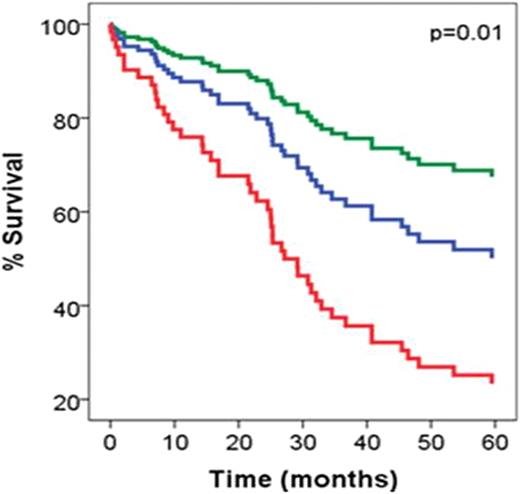Abstract
Abstract  2883
2883
In MM, increasing evidence indicates progressive clonal evolution A novel polyclonal immunoassay specific for the different light chain types of intact immunoglobulins (Ig) (heavy/light chain assays; HLC) and the serum free light chain (FLC) test enable measurement of changes in the production of clone specific Ig and of the non-involved polyclonal Ig of the same isotype. By calculating the HLCratio the relationship between clonal and non clonal plasma cells can be assessed. Here we evaluate the prognostic value of the HLCratio, construct a two tiered prognostic model employing the HLC and FLC tests, and use these assays to analyze the clonal tide in patients (pts) with MM.
103 previously untreated pts with MM were enrolled (35 IgGκ, 17 IgGλ, 29 IgAκ, 22 IgAλ). ISS stage I: 39 (38%), stage II: 42 (41%), stage III: 22 (21%) pts. Median age: 66years (range 32–86). 82 pts with a minimum of 5 serum samples were followed for a median of 36 mos (range: 57 days -133 mos).
Serum FLC and HLC (IgGk/IgGl, IgAk/IgAl) measurements were made using polyclonal antisera assays (Freelite™, Binding Site, Birmingham, UK. and, Hevylite™, Binding Site, Birmingham, UK). Serum protein electrophoresis and immunofixation were conducted on a SEBIA Hydrasys II platform. Survival analysis was performed using the SPSS v 18 programme.
Risk stratification model utilising serum FLC and HLC ratios for 103 multiple myeloma patients. Patients had 0 (green line), 1 (highly abnormal FLC ratio (<0.1 or >30), or highly abnormal HLC ratio (<0.022 or >45); blue line) or 2 (highly abnormal FLC and HLC ratios; red line).
Risk stratification model utilising serum FLC and HLC ratios for 103 multiple myeloma patients. Patients had 0 (green line), 1 (highly abnormal FLC ratio (<0.1 or >30), or highly abnormal HLC ratio (<0.022 or >45); blue line) or 2 (highly abnormal FLC and HLC ratios; red line).
The comparison of FLC and HLC values over the follow up period revealed concordance of changes in 75 pts (91.5%). In 1 pt after 78 days a >50% reduction in dFLC (and FLCratio) indicated a partial response, whereas HLCratios (and IgGk concentrations) showed no response; this indicates the existence of clones with different sensitivity to myeloma therapy. FLC escape was noted in 1 pt with increasingly abnormal free FLC values while HLCratios remained stable. In 4 pts, increasingly abnormal HLCratios at the same time as FLC values were stable or normalising indicated outgrowth of clones producing intact Ig only. One additional pt showed an increasingly abnormal HLCratio due to subtle suppression of the polyclonal Ig while the monoclonal concentration remained constant.
Highly abnormal HLCratio correlates with shorter survival and a risk-stratification model combining HLC and FLCratio revealed marked discriminative power. Monitoring pts with FLC and HLC assays showed significant changes in clonal protein production as an indication of a major clonal tide in about 10% of myeloma pts.
Faint:The Binding Site Ltd.: Employment. Bradwell:The Binding Site Ltd.: Consultancy, Equity Ownership, Patents & Royalties. Young:The Binding Site Ltd.: Employment. Harding:The Binding Site Group Ltd: Employment.
Author notes
Asterisk with author names denotes non-ASH members.

This icon denotes a clinically relevant abstract


